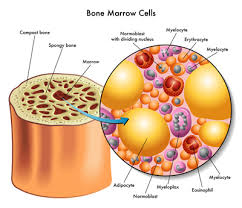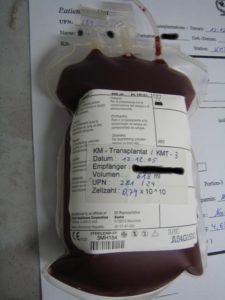
Recently Diagnosed or Relapsed? Stop Looking For a Miracle Cure, and Use Evidence-Based Therapies To Enhance Your Treatment and Prolong Your Remission
Multiple Myeloma an incurable disease, but I have spent the last 25 years in remission using a blend of conventional oncology and evidence-based nutrition, supplementation, and lifestyle therapies from peer-reviewed studies that your oncologist probably hasn't told you about.
Click the orange button to the right to learn more about what you can start doing today.
- You are here:
- Home »
- Blog »
- Multiple Myeloma »
- Stem Cell Transplant for Myeloma- Yes or No?
Stem Cell Transplant for Myeloma- Yes or No?

“hematopoietic stem cell transplantation (HSCT) survivors are at risk of developing long-term complications, such as endocrinopathies, musculoskeletal disorders, cardiopulmonary compromise and subsequent malignancies.”
Hi David- I was diagnosed with Multiple Myeloma. I have had four cycles of the drugs you mentioned just halfway through the second cycle. I am wondering if I need to do the stem cell transplant. I am 54 only thing weird was my IGa protein numbers which are now in the normal range.
I had a few broken ribs over the summer and some pretty painful back spasms but most are getting better now. Doing the Velcade Revlimid treatment I like reading your story so positive. Bud
Hi Bud-
To confirm, are you saying that you have undergone four cycles of induction therapy with RVD aka Revlimid, Velcade and Dexamethasone? Just making sure I understand your history.
Your question “Wondering if I need to do the auto stem cell transplant” depends on your priorities.
I need to confirm your situation:
- You are young as MM goes at 54. My thinking is that your time horizon is decades. I’m confirming this because the average MM survival is 5-7 years. Your therapy plan should take that statistic into account.
- You experienced bone damage at diagnosis. This is relevant because it indicates that you were at stage 2 or 3 when you were diagnosed.
- You say that your IgA levels are in the normal range after four cycles, four months of induction therapy of RVD?
In order to talk about an autologous stem cell transplant, or I should say, the pros and cons of an ASCT for you, I need to look at your-
- M-spike
- Freelight chain assay
- any recent imaging testing to see how your bone involvement is doing?
- Complete blood count aka CBC to see how your blood is doing- red blood cells, white, hemoglobin, etc.
- Any kidney involvement? How is your creatinine and BUN levels?
Long story short, Brad, you are facing the choice discussed in the cure vs. control debate linked below. The article was written by a MM Specialist named S. Vincent Rajkumar, MD. Dr. Rajkumar is one of the best MM Specialists in the world.
Research shows that an ASCT will result in a host of short, long-term and late stage side effects with a small chance of a longer PFS aka first remission.
Working to control your MM will result in few if any side effects but a shorter PFS, more in and out of remission, relapse.
David Emerson
MM Survivor
MM Cancer Coach
Director PeopleBeatingCancer
Recommended Reading-
- Surviving Multiple Myeloma- Autologous Stem Cell Transplant-
- Multiple Myeloma Treatment- “Curative” Therapy for is Anything But…
- Stem Cell Transplant, MM, PTSD
- How Long Can a Young Person Live with Multiple Myeloma?
_____________________________________________
Long-term health impacts of hematopoietic stem cell transplantation inform recommendations for follow-up
“Advances in transplantation techniques and supportive care strategies have resulted in a significant improvement in survival of those who have undergone treatment. However, hematopoietic stem cell transplantation (HSCT) survivors are at risk of developing long-term complications, such as endocrinopathies, musculoskeletal disorders, cardiopulmonary compromise and subsequent malignancies.
These complications have a direct impact on the morbidity and mortality experienced by HSCT survivors. Two-thirds of HSCT survivors develop at least one chronic health condition; while a fifth develop severe or life-threatening conditions. HSCT patients who have survived for at least 5 years post-transplantation are at a fourfold to ninefold increased risk of late mortality for as long as 30 years from HSCT, producing an estimated 30% lower life expectancy compared with the general population.
“Although not often openly acknowledged, “cure vs control” is the dominant philosophical difference behind many of the strategies, trials, and debates related to the management of myeloma.
Should we treat patients with myeloma with multidrug, multitransplant combinations with the goal of potentially curing a subset of patients, recognizing that the risk of adverse events and effect on quality of life will be substantial?
Or should we address myeloma as a chronic incurable condition with the goal of disease control, using the least toxic regimens, emphasizing a balance between efficacy and quality of life, and reserving more aggressive therapy for later?
To be sure, if cure were known to be possible (with a reasonable probability) in myeloma, it would undoubtedly be the preferred therapeutic goal of most patients and physicians. But this is not the case. Myeloma is generally not considered a curable disease; however, new definitions of cure have been suggested, including operational cure, which is defined as a sustained complete response (CR) for a prolonged period.1,2 Cure vs control is debated because the strategies currently being tested are not truly curative but rather are intended to maximize response rates in the hope that they will translate into an operational cure for a subset of patients…


